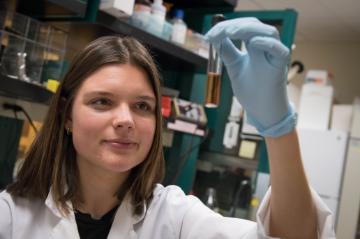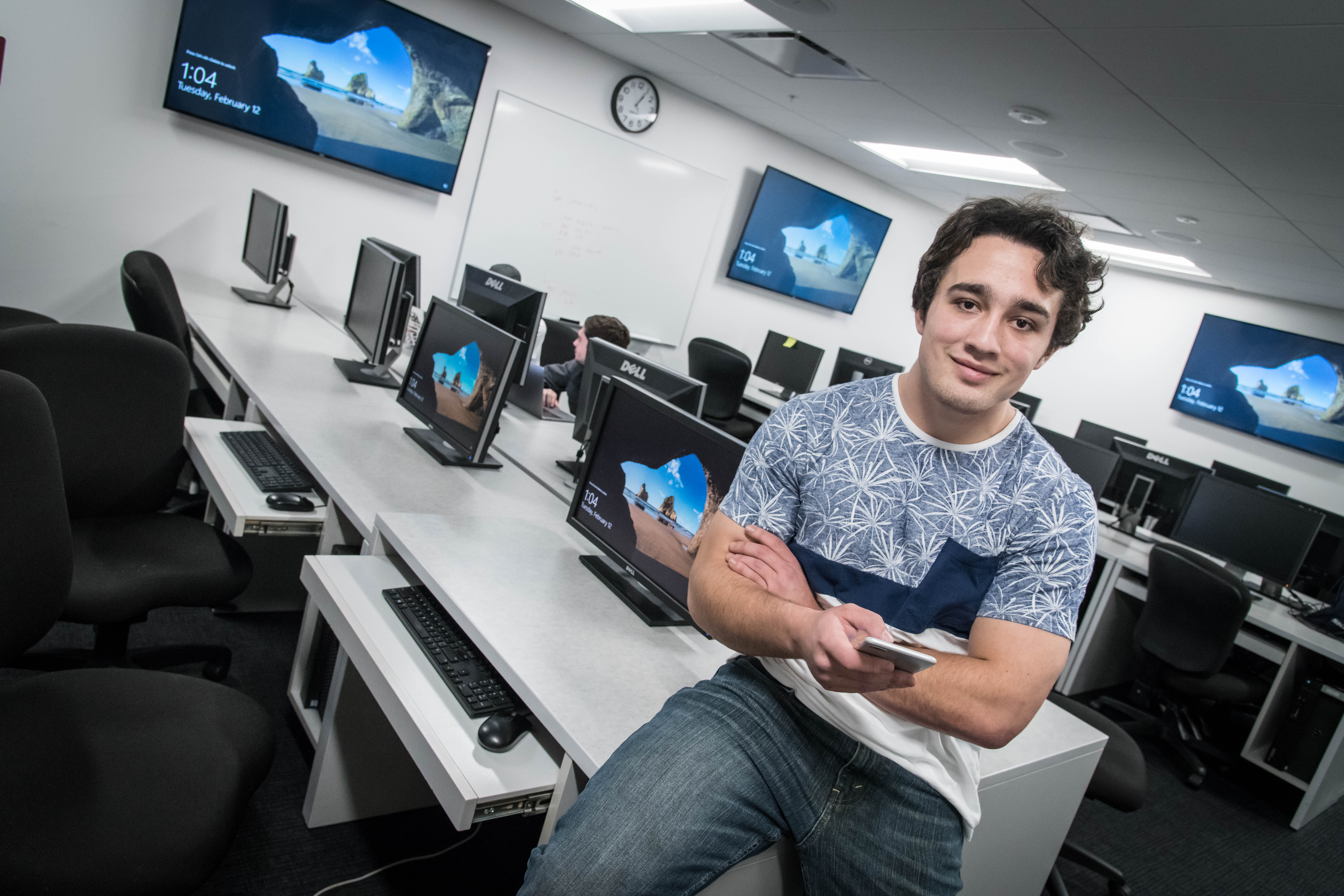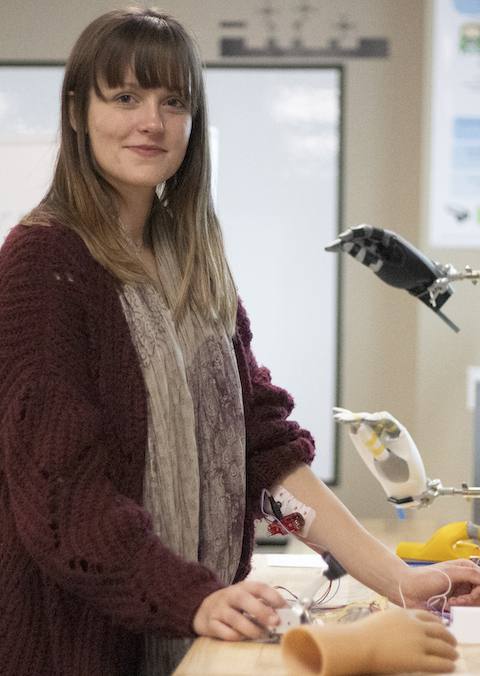
Invent Amazing
SCU Celebrates 2019 National Engineers Week
We call them “Humanitarian Engineers”—students designing and refining the products that can make a positive social impact.
There is Claire Hultquist ’19, working diligently on a device to detect cervical cancer for women in developing nations. Bobby Kresge ’19 is creating an app to connect SCU students with mental health resources on campus, while Jamie Ferris ’19 is part of an effort to develop a low-cost prosthetic hand.
And Riley Albright-Borden ’19? She’s knee-deep in an urban garden, experimenting with a sustainable farming system that relies on less water and no soil.
As America’s 68th National Engineers Week kicks off this week, the four seniors join the rest of SCU’s 1,900-plus engineering students—both undergrad and graduate—in a variety of disciplines aligning perfectly with eWeek’s 2019 theme: “Engineers: Invent Amazing.”
How amazing? From targeted drug delivery to engineering smart buildings, Bronco engineers are advancing a broad range of research. And as we’re celebrating this remarkable work, we’re also building a future for engineering on campus: Santa Clara’s Sobrato Campus for Discovery and Innovation, a state-of-the-art facility to bring together engineering and the sciences for collaboration in solving some of the world’s most pressing and complex problems. Ground was broken, and the facility is expected to open in 2022.
The slate of eWeek events that runs from Tuesday, Feb. 19 through Saturday, Feb. 23 includes a full lineup of social and informational activities, in addition to an art show, a diversity dinner, and an engineering research showcase.
As for the four SCU humanitarian engineers we mentioned above, they have been invited to the East Coast in April, along with some teammates, to pitch their social impact projects to a panel of experts at the Global Health & Innovation Conference to be held at Yale University.
Here's a quick overview of their work:

Bioengineering student Claire Hultquist works on a project to detect cervical cancer. Photo by Charles Barry
Name: Claire Hultquist ’19, bioengineering/public health
Project: CERVIS, Cervical cancer Early Response Visual Identification System
Problem/mission: Eighty-five percent of the world’s cervical cancer cases occur in countries where there is little or no reliable health care. Creating a low-cost device that is easy to use and offers quick test results can help provide early diagnoses and treatment.
Product description: The latest CERVIS resembles a mascara wand that fits inside a clear plastic tube. The woman inserts the wand into her vagina, then places it back in the tube that contains a liquid that allows bacteria to grow. The tube is handed to a health care worker, who puts it inside an incubator. After 48 hours, the tube is removed and checked for growth of a certain strain of bacteria associated with cervical cancer. If that bacteria is present in the tube, the health care worker will contact the woman for further screening or treatment.
Why she got involved: “I love the microbiology aspect of our project, and I can definitely see myself going back to get more education in that field. I have a strong passion for women’s health—and concern about the health disparities that go along with the health care system.”

Bobby Kresge is developing a mental health care app. Photo by Charles Barry
Name: Bobby Kresge ’19, computer engineering
Project: A mobile mental health application called UFEEL, Understanding Feelings Effectively and Enhancing Life that assesses and provides options.
Problem/mission: Many college students suffer from anxiety or depression. The SCU campus mental health resources are excellent, but only when they are used. It's important to make sure that students know that resources are available, but students get so many email blasts from the school that this information can get lost. A simple tool with all the contact information is an easy way for students to access resources they don’t know about. Social media makes it much easier for students to use the tools and help themselves.
Product description: The software is being designed to feature an “emergency call button” to help a student contact someone right away, like a trusted friend or a close relative. The app also will feature push notifications to help remind students to check on how they’re feeling, or send them a helpful message like “Go for a run” or “Talk to a friend”—or asks, “What was the best part of your day?”
Why he got involved: “I want to help break the stigma of mental illness on campus. I also want to use technology to help make things better. This is a real issue on college campuses, and students shouldn’t feel alone or ashamed about it. Self care is not selfish care, it's a critical part of a healthy life. I want this tool to support healthy lives for the students of SCU.”

Mechanical engineering student Jamie Ferris is helping to design a prosthetic hand. Photo by Andrea Yun
Name: Jamie Ferris ’19, mechanical engineering
Project: HELP Hand, Human-centered Electric Prosthetic Hand
Problem/mission: Assist amputees in regaining their mobility and dexterity through artificial limbs—in this case, a bio-electrical artificial hand. Working with Jaipur Foot Foundation based in Rajasthan, India, SCU students are helping the nonprofit design a lower-cost, more functional hand that is better suited to the amputees than the versions available now.
Product description: Using an existing prosthetic glove, Ferris and others are designing the entire mechanical hand as well as the bio interface that involves circuitry, a tiny motor, and tendons running through a pulley system to allow finger curling. Myoeletric sensors can detect the voltage potential created when muscles are activated. That voltage reading can then be used as an indicator of the human’s intent to move the prosthesis, and through a circuit can be translated to whatever motor movement is programmed into the artificial hand.
Why she got involved: “I feel like I’m contributing to a really important design project where we have the potential to really improve the lives of thousands of people.”

Mechanical engineering student Riley Albright-Borden is helping to design an aquaponics system. Photo by Andrea Yun
Name: Riley Albright-Borden ’19, mechanical engineering
Project: Aquaponics: Design of a Sustainable Integrated Farming System
Problem/mission: Low-income populations in urban areas often lack access to fresh produce, and with few opportunities for urban gardening, aquaponics can address the problem because the integrated farming system does not require soil. Aquaponics involves grow beds for vegetables and a tank that holds fish—in this case, goldfish and koi. The combination of plants and waste from the fish creates a successful nitrogen cycle that optimizes plant growth. Because it uses significantly less water than traditional farming, and is a closed-loop system, in the right environments it’s more sustainable.
Product description: SCU engineers have built an aquaponics system at Father Larry’s Farm in San Jose, where solar panels run the water pump that cycles the water and other equipment. Additionally, a sensor system will send data on pH, temperature, dissolved oxygen, and electrical conductivity/nitrate to help monitor the water quality. Produce like lettuce, spinach, kale, and cabbage harvested from the system is being used to supplement the meals served by nonprofit Loaves & Fishes.
Why she got involved: “Santa Clara was drawn to this project locally after we learned about the large population of people in San Jose who are food insecure. I really like this project because we’re helping people and we’re serving a community.”
Bioengineering student Claire Hultquist's lab work on CERVIS: Cervical cancer Early Response Visual Identification System. Photo by Charles Barry